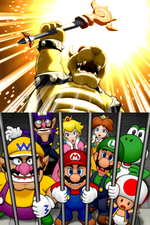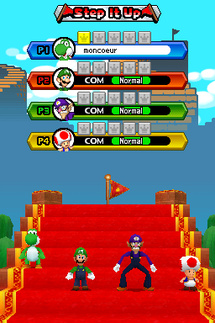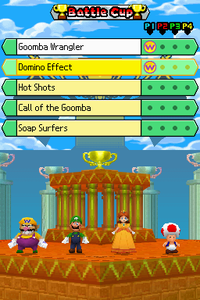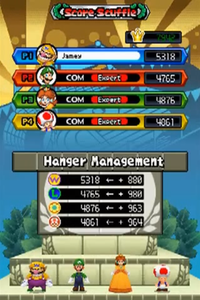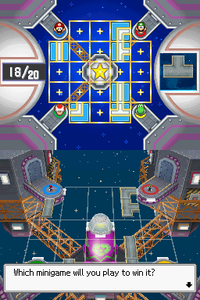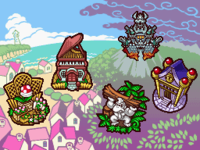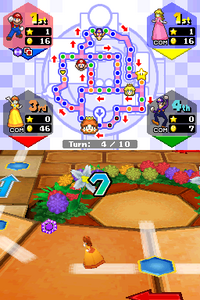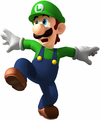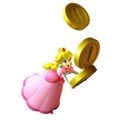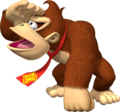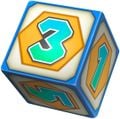Mario Party DS
Template:Infobox Mario Party DS is the fourteenth installment in the Mario Party series, the third for handheld consoles, and the only one for the Nintendo DS. This is the last Mario Party game to be developed by Hudson Soft, which was succeeded by Nd Cube in 2012. This Mario Party game is unique for having the characters to be shrunken down to a very small size and competing in a "mega world" for the majority of the game. It includes more than seventy new minigames and five new game boards. Its functions include touch control, microphone control and dual-screen challenges. It is possible for up to four players to play in wireless mode using only one game card. This would be the last installment to feature the traditional Mario Party gameplay until Super Mario Party, released for the Nintendo Switch eleven years later.
Mario Party DS was re-released for the Wii U through the Virtual Console on April 21, 2016 in North America and Europe, in Australia on April 22, 2016, and in Japan on April 27, 2016. It is the third and final Mario Party game to be rereleased for the Wii U's Virtual Console; the others being Mario Party 2 and Mario Party Advance.
Story
One night in the Mushroom Kingdom, five Sky Crystals in the sky fall to the land. One falls near Mario, who explains it to his friends the next day. Suddenly, Kamek flies overhead the gang, dropping invitations to a feast in Bowser's Castle to apologize for his wicked behavior. Unintentionally, Donkey Kong and Diddy Kong get invitations as well.
Curious, the crew sets off for the castle, but upon their arrival, they find it was a trick as Bowser and Bowser Jr. trap Mario and his friends in a cage when they enter. With the group trapped, Bowser uses a magic wand called the Minimizer to shrink them all down to the size of chess pieces, and they are thrown out to a distant location by Kamek. This leaves Bowser to look for the five shining objects, the Sky Crystals, in peace. Displeased by the outcome, the gang wakes up outside and decides to head for the castle to settle the score with Bowser. The desire to be the one Superstar that defeats Bowser and his cronies causes Mario and his other seven friends to pit themselves against each other for the title along the way.
At the beginning of their journey, Wiggler begs the crew for help, as a Piranha Plant has infested his garden. The Piranha Plant is eventually defeated by the character who becomes the Superstar, leading to Wiggler rewarding them with a Sky Crystal that landed in his garden.
Soon after, Toadette finds and requests the group to defeat a Hammer Bro that was abusing her instruments in her music room. The Hammer Bro is defeated in a drum-off by the Superstar, and Toadette gives a Sky Crystal she found to the gang as her thanks.
Afterwards, they set off for the jungle, where they find Diddy Kong, who shows the heroes that Donkey Kong was turned to stone by a Dry Bones. The Superstar manages to defeat Dry Bones in his arena, leading to Donkey Kong's restoration and Diddy Kong rewarding them with a Sky Crystal he found. Donkey Kong and Diddy Kong quickly recall the free food promised at Bowser's Castle, and eagerly head off towards the castle.
Upon nearing the castle, the crew find a Koopa Troopa from a library asking for help, as Kamek has trapped his grandfather, Koopa Krag, in one of his library books. The Superstar defeats Kamek at the end of a long hallway, and Koopa Krag is freed from the book, giving them a Sky Crystal as thanks.
Eventually, they reach Bowser's Castle, where they are promptly stuffed in a pinball machine by Bowser and Bowser Jr., the latter using it to mess with them. The one revealed to be the Superstar is taken from the pinball machine to be shrunk again and crushed by Bowser, but Donkey Kong and Diddy Kong arrive, the former unintentionally smashing the Minimizer by knocking it out of Bowser's hands and stepping on it afterwards, the actions reverting the playable characters back to their original states.
Reluctant to give up, Bowser reveals one more surprise: the Megamorph Belt. The device transforms Bowser into Blockhead Bowser, and the aforementioned Superstar does battle with him. Upon Bowser's defeat, Bowser and his son are tied up, Mario taking back the final Sky Crystal he initially found from them. Now in close proximity of each other, they are magically formed together to make a crystal DS, allowing play of Triangle Twisters, the fun challenge mentioned by Bowser, whose desire to have the Sky Crystals being to try the fun challenge. After hearing this, Mario decides to untie the two, and they all play Triangle Twisters together, thus ending the story. Nearby, Donkey Kong and Diddy Kong eat the entire feast by themselves, being quite satisfied.
Characters
Mario Party DS has 8 playable characters and 5 board hosts, with a boss for each board. Other characters with little to no role are also present.
Playable characters

|

|
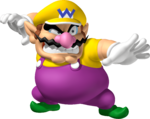
|

|

|

|
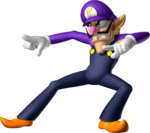
|

|
Board hosts/bosses
| Wiggler's Garden | Toadette's Music Room | DK's Stone Statue | Kamek's Library | Bowser's Pinball Machine |
|---|---|---|---|---|
| Board Host | Board Host/Boss | |||
| Wiggler | Toadette | Diddy Kong | Kamek | Bowser |

|

|
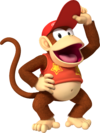
|

|
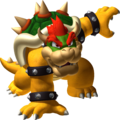
|
| Boss | ||||
| Piranha Plant | Hammer Bro | Dry Bones | ||

|
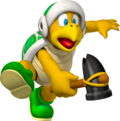
|

| ||
Supporting cast
- Donkey Kong (Found in DK's Stone Statue)
- Koopa (Found in Kamek's Library)
- Koopa Krag (Found in Kamek's Library)
- Bowser Jr. (Found in Bowser's Pinball Machine)
Minigame enemies
Team names
For the Tag Battle setting in Party Mode, each combination of playable characters create one unique team name. The list of possible results are shown below:
Modes
Story Mode (1 Player)
A single-player mode that follows the storyline of the game. It puts the player through the five boards of the game, requiring them to win a Battle Royal on each board and defeat the boss of it in a minigame to progress. CPU characters are chosen at random, each board lasts for 10 turns, and Bonus Stars are not awarded. If a CPU player wins the board, they attempt to face the boss, but lose, and the player has to play the board again.
Party Mode (1-4 Players)
The main mode of the game, where the player competes against several human-controlled or computer-controlled players on a party board in either a Battle Royale, Tag Battle or Duel Battle.
Minigame Mode (1-4 Players)
A mode where the player can play six games that use the pool of minigames available in a variety of challenges that don’t take place on the game boards, those being Free Play, Step It Up, Battle Cup, Score Scuffle, Boss Bash and Rocket Rascals. The player can pit themselves against up to three other human-controlled players in the Multiplayer version of this mode.
Step It Up
Step It Up is a minigame competition playable only by four players. The aim of this challenge is to see who can be the first to win 3, 5 or 7 minigames, depending on the options chosen, and after each minigame played the characters who win the minigame get to climb one step of the staircase. Minigames are chosen randomly, and the first player to win 3, 5, or 7 minigames wins the mode. This contest is a reincarnation of a competition that has appeared in previous installments in the series.
The player can choose to play only 4-player, 1-vs-3 and 2-vs-2 minigames, or a randomized mix of all three. For 1-vs-3 and 2-vs-2 minigames, teams are chosen at random each time when the player chooses the random minigame type setting, unless the player specifically chooses either minigame type, where the teams would be decided at the start of the competition.
- Names in other languages
| Language | Name | Meaning | Notes |
|---|---|---|---|
| Japanese | かちぬきバトル[?] Kachinuki Batoru |
Tournament Battle | |
| Korean | 승자진출전[?] Seungjajinchuljeon |
Winner Entry Game | |
| Spanish (NOA) | Poco a poco[?] | Bit by bit | |
| Spanish (NOE) | Escalera hacia el éxito[?] | Stairs towards the success |
Battle Cup
Battle Cup is a minigame competition playable only by four players. The objective is to win as much of the Cup Course, a collage of five consecutive minigames that the human player either selects manually or lets the game choose five randomly, as possible. Despite only 4-player and Battle minigames being playable in this contest, multiple victors are allowed at the end of each minigame, however, ties between all four players will result in no one getting the minigame win. If multiple players end up winning the most minigames at the end of the Cup Course, the players will roll Dice Blocks to decide the real winner, the highest roller being declared the winner.
- In-game description
"Choose a specific minigame course, then battle to come out ahead!"
- Names in other languages
| Language | Name | Meaning | Notes |
|---|---|---|---|
| Japanese | バトルカップ[?] Batoru Kappu |
Battle Cup | |
| Korean | 배틀컵[?] Baeteulkeop |
Battle Cup | |
| Spanish | Torneo por victorias[?] | Tournament by victories |
Score Scuffle
Score Scuffle is a minigame competition playable only by four players. The players play ten specific minigames consecutively, converting the results for each player to points after each minigame and adding it to each player's current score. The player with the most points after the ten minigames is the winner. The highest amount a player can get in a minigame is 1000 points, with the exception of Get the Lead Out (whose highest amount is 999 points). As such, the maximum amount of points a player can have after the ten minigames is 9,999 points. The default high score for Score Scuffle is 0 points.
The minigames and the order in which they are played are as follows:
- Rail Riders
- Domino Effect
- Cherry-Go-Round
- Study Fall
- Get the Lead Out
- Whomp-a-thon
- Hedge Honcho
- Pedal Pushers
- Hanger Management
- Raft Riot
- In-game description
"Compete in a series of minigames to earn as many points as possible!"
- Names in other languages
| Language | Name | Meaning | Notes |
|---|---|---|---|
| Japanese | スコアアタック[?] Sukoa Atakku |
Score Attack | |
| Korean | 스코어어택[?] Seukoeo Eotaek |
Score Attack | |
| Spanish | Torneo por puntos[?] | Tournament by points |
Boss Bash
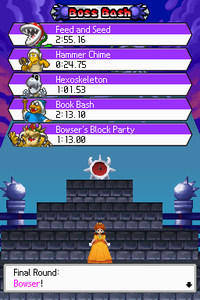
Boss Bash is a single-player minigame challenge, where the player must face in the following order: the Piranha Plant, the Hammer Bro, the Dry Bones, Kamek and Bowser in their respective boss minigames. The aim is to do so as quickly as possible to try and beat the current best times, as the minigames are timed in this challenge. If the player is defeated in any of the minigames, the challenge ends and the times for minigames the player did beat are not recorded. The default best times for the five bosses are 5:00:00, while the default overall best time is 25:00:00.
The boss minigames played and the order they are played are as follows:
- In-game description
"Take on the boss minigames to get the best time you can!"
- Names in other languages
| Language | Name | Meaning | Notes |
|---|---|---|---|
| Japanese | ボスタイムアタック[?] Bosu Taimu Atakku |
Boss Time Attack | |
| Korean | 보스타임어택[?] Boseu Taim Eotack |
Boss Time Attack | |
| Spanish | Enemigos finales[?] | Final enemies |
Rocket Rascals
Rocket Rascals is a four-player minigame competition. The players must win minigames to acquire and place bridge pieces on the square 5x5 grid. The first to make a path from their corner of the grid to the rocket with the bridge parts is the winner. If multiple players have paths to the rocket made at the same time by a third party, the players roll Dice Blocks to decide who actually wins, the highest roller winning. If one of the multiple players finished the bridge, then the one who did wins without a Dice Block roll. Additionally, the game will end in a tie if 20 turns pass without anyone making a route to the rocket.
At the start of each turn, a roulette randomly decides which bridge piece will be up for grabs in the next minigame, which gets decided by a minigame roulette. The player who wins the minigame gets the previously shown bridge piece and can place it on any unoccupied space of the 5x5 grid, and the turn will end afterwards, the cycle repeating until someone makes a path to the rocket. If the minigame ends with multiple winners, or if nobody wins, nobody gets the piece. If a player has all ways of reaching the rocket prevented for them, the blocking pieces will be removed.
Occasionally, Bowser Jr. may show up after a bridge part is decided and will do one of the following, as decided through a roulette spin:
- Crosspiece Crisis: Every minigame, the player will play for a Crosspiece.
- Turnaround Madness: Bowser Jr. will scatter the pieces in different areas.
- Tiebreaker Trouble: Bowser Jr. gets to choose where to place the piece if a tie occurs.
- Bridge Breaker: Bowser Jr. takes away all the pieces up to that point, making everyone start again from scratch.
- Final 5 Frenzy: The game is skipped to the last five turns.
- In-game description
"Build a bridge to a rocket! Win your pieces by playing minigames!"
- Names in other languages
| Language | Name | Meaning | Notes |
|---|---|---|---|
| Japanese | ミニゲームブリッジ[?] Minigēmu Burijji |
Minigame Bridge | |
| Korean | 미니게임브릿지[?] Minigeim Beuritji |
Minigame Bridge | |
| Spanish | Carrera espacial[?] | Space Race |
Puzzle Mode (1-2 Players)
A mode where the player can play six puzzle-action games, the majority being classics from previous Mario Party games.
Those minigames and the order in which they are showcased are as follows:
This mode introduces the new touch-controlled puzzle game, Triangle Twisters, which offers two play modes, Frenzy Mode and Focus Mode. Additionally, the player can pit themselves against another human-controlled player in the Multiplayer version of this mode.
Multiplayer (2-4 Players)
Using one game card, players can use DS Download Play to wirelessly play together in Party Mode, Minigame Mode (2-4 Players), Puzzle Mode and Extra Mode (2 Player) with nearby Nintendo DS users.
Extras Mode (2 Player)
A multiplayer exclusive mode that includes games designed for two: the cooperative Pen Pals and the competitive Desert Duel.
Gallery
- Main article: List of Mario Party DS collectibles
Includes over 120 collectibles that can be viewed at the player's discretion when unlocked. This mode also allows them to listen to the game's music and watch the cutscenes seen in Story Mode when viewed at least once in it.
Gameplay
The gameplay in Mario Party DS follows the style of the console games that preceded it. Up to four players take turns to roll a Dice Block that shows numbers from 1-10, which decides how far players move across boards. The goal is to acquire the most Stars through the conditions decided on each of the boards. After all players have had their turn, the type of minigame is determined by what color space the player lands on (red or blue). If the player landed on a green, duel or friend space, the player's color is randomly red or blue. Landing on a Bowser space will result in the player's color turning red. For instance, if one player lands on a red space while three other players land on a blue space, a 1 vs. 3 minigame is held, with the red player on the solo side and the three players on the other side. The players then engage in a minigame, and whoever wins the minigame earns 10 coins.
If the combined total dice roll for all four players for the turn is a multiple of 10, a Battle Minigame is triggered instead. All players will pay a certain number of Coins into a "pot" before the minigame, with any players who have insufficient Coins only paying what they have on them. After the minigame, each player will get back 50, 30, 20, or 0 percent of the Coins in the pot, depending on where they rank in the minigame. If the Coins cannot be divided up equally, the leftovers will be awarded to a random player. The number of Coins a player must pay is determined by the formula [current turn number × 2]; for example, if the Battle Minigame is triggered in Turn 7, all players must pay 14 Coins.
The turn will end afterward, the process repeating until the set number of turns have passed. The game will end once the set number of turns have passed, and the total number of Stars and coins the players have collected will be tallied, Stars being the primary factor for rankings while coins are the tie-breakers.
When there are five turns remaining, Bowser helps the player who is in last place in an event called the Final 5 Frenzy. That player is given a prize determined by spinning a roulette. For the remaining five turns, all Friend Spaces are changed to Duel Spaces.
At the end of a Party Mode game, Bonus Stars may be rewarded to the players who have excelled the most at certain criteria. If there is a tie between three or less players, the Stars are awarded to all of the tied players. Three of these six bonuses are chosen at random:
- Mini-Game Star - Awarded to the players who have won the most minigames.
- Green Star - Awarded to the players who have landed on the most ? Spaces.
- Running Star - Awarded to the players who have moved the most spaces using Dice Blocks.
- Item Star - Awarded to the players who used the most items.
- Hex Star - Awarded to the players who laid down the most hexes.
- Friendship Star - Awarded to the players who landed on the most Friend Spaces.
Spaces
| Space | Description |
|---|---|
 Blue Space |
The most common space, the Blue Space gives players three coins if they land on it. It gives their section in the heads up display a blue color, which is used to determine pairings in minigames. |
 Red Space |
A fairly common space, the Red Space takes three coins from players that land on it. It gives their section in the heads up display a red color, which is used to determine pairings in minigames. |
 Green Space |
This space causes certain events to happen that can benefit the player, harm the player, benefit a number of players, or harm a number of players. It gives the player's section in the heads up display a green color, which is used to determine pairings in minigames. In this case, the green color eventually flashes to red or blue. |
 Friend Space |
When they land on this space in Battle Royale, players can select one opponent to be a friend. Both then receive 5 coins. In Team Battle, the player and one of the two opponents get 5 coins. It gives the player's section in the heads up display a green color, which is used to determine pairings in minigames. |
 Duel Space |
Engages with an opponent of the player's choice into a duel minigame. The winner gets to use a roulette that determines the reward from the opponent. It gives the player's section in the heads up display a green color, which is used to determine pairings in minigames. It replaces the Friend Space in the Final 5 Frenzy. |
 Bowser Space |
Any players that land here causes Bowser to arrive. Bowser causes a series of events that harms usually whoever landed on the space. It gives their section in the heads up display a red color, which is used to determine pairings in minigames. Bowser can cause these events:
|
Star Space |
Once players reach this space, they can pay 20 coins to receive a Star. Other boards may have different conditions players need to fulfill to earn a Star. Unlike other spaces, this space cannot be landed on (unless a Star spawns directly on a player), and this space does not subtract from the dice roll. |
Items
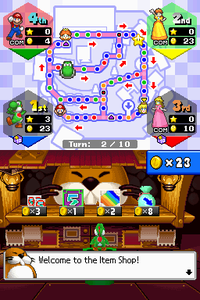
Alongside normal items seen in earlier Mario Party console titles, Mario Party DS introduces a new type of item that is also used during board gameplay: Hexes. The normal items are most often acquired through purchase at an Item Shop, and may be used by players to gain an advantage. Alternatively, Hexes can be found only at Hex Areas and can be placed on the board to usually hinder the player who lands on the space where it was set. Each player may only carry three items/hexes at one time.
Normal items
Mario Party DS is the first Mario Party game to have standard items since Mario Party 4. These items function like (and are based on) the standard items from the first four installments in the series. They can be bought at shops on each board, run by a Monty Mole. In addition, for the first time in the series, players can purchase more than one item in one stop.
| Item | Description | Shop Price |
|---|---|---|
 Double Dice Set |
Allows the player to roll two Dice Blocks. | 3 Coins |
 Triple Dice Set |
Allows the player to roll three Dice blocks. | 7 Coins |
 Halfway Dice Block |
Allows the player to roll a Dice Block with the numbers 1 through 5. | 1 Coin |
 Warp Dice Block |
Causes the player to warp to a random space on the board, then roll. | 2 Coins |
 Snag Bag |
Allows the player to steal a random item from an opponent of their choice. | 8 Coins |
 Star Pipe |
Warps the player directly to the Star Space, allowing them to buy the Star if they wish and if they have enough coins, then roll. | 15 Coins |
 Block Sensor |
Causes the next space the player lands upon to contain a Hidden Block. | 20 Coins |
 Grab Bag |
Removes all of the player's current items and hexes and gives them a Star Pipe, Block Sensor, and Triple Dice Set. | 25 Coins |
Hexes
Hexes are items placed on spaces to usually hinder the player who lands on a set Hex. If a character lands on their own hex, they receive 5 coins, much like landing on their own Character Space in previous Mario Party games. The only exceptions to this is if the player lands on a Coin Block or Star Block they placed, where they will reap the benefit of the hexes instead. Unlike character spaces, hexes go away after being landed on. Hexes can be replaced by other hexes.
| Name | Description |
|---|---|
10-Coin Hex |
Causes the player who lands on the hex to give ten coins to the one who set it. |
20-Coin Hex |
Causes the player who lands on the hex to give twenty coins to the one who set it. |
Coin Swap Hex |
Causes the player who set the hex and the player that lands on it to swap coin totals. |
1-Star Hex |
Causes the player who lands on the hex to give one Star to the one who set it. |
2-Star Hex |
Causes the player who lands on the hex to give two Stars to the one who set it. |
Space Swap Hex |
Both the player who lands on the hex and the one who placed it swap positions on the board. |
Star Block |
The player who lands on this hex can hit a block with a 1 through 3 on it to gain that many stars. |
Coin Block |
The player who lands on this hex is able to hit a block containing coins, by pressing the A button repeatedly, to gain as many as possible in ten seconds. |
Boards
| Picture | Name | Description | Boss | Boss Mini-Game |
|---|---|---|---|---|

|
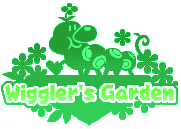
|
The player must find the star and buy it for 20 coins. Once the player claims the star, it will go to another location. | Piranha Plant
|
Feed and Seed |
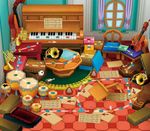
|
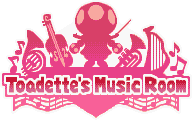
|
Players must find the Music Notes and buy stars from them for 5-30 coins. | Hammer Bro
|
Hammer Chime |
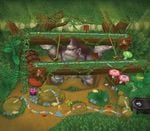
|
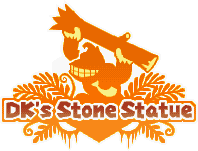
|
The star on this board is always located on the second-to-last space. Players can buy up to 5 stars at once on this stage, depending on how many coins they have at the time. A star will cost 20 coins. | Dry Bones
|
Hexoskeleton |
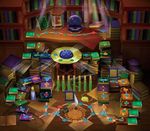
|
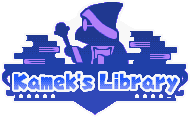
|
On this board, there are three magic jars to find. The player will need to pay 10 coins to open a magic jar. One contains a star, one 5 coins, and the other sends them back to the start. This is completely random and will change once someone finds the star. | Kamek
|
Book Bash |
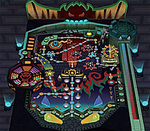
|
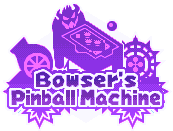
|
The player must find the star and buy it for 20 coins. Once the player claims the star, it will go to another location. | Bowser
|
Bowser's Block Party |
Minigames
- Main article: List of Mario Party DS minigames
Mario Party DS features 73 minigames (71 in the Korean version, as two minigames, Shuffleboard Showdown and Chips and Dips, were removed possibly because of the gambling themes present in both of them) from seven different categories. There are 32 4-player minigames (29 of which are also Duel minigames), 12 1-vs-3 minigames (11 in the Korean version), 13 2-vs-2 minigames (three of which are also Duel minigames), 32 Duel minigames (29 of which are 4-player minigames and three of which are 2-vs-2 minigames), five Battle minigames (four in the Korean version), five Boss minigames and six Puzzle minigames. Of these, 58 are unique, 4 are minigames with the goal of collecting coins, and 11 are specialized.
Reception
Critical reception of the game was generally mixed to positive, garnering a 72 on Metacritic and 72.17% on GameRankings. Many critics praised the game as a major improvement over Mario Party Advance and Mario Party 8, the latter which was released the same year, and was praised for returning to the traditional gameplay from the console games and its multiplayer, graphics, minigames, and board designs. Criticism tended to focus on its perceived similarity to the previous games and its absence of online multiplayer.
| Reviews | |||
|---|---|---|---|
| Release | Reviewer, Publication | Score | Verdict |
| Nintendo DS | Frank Provo, GameSpot | 8/10 | "Mario Party DS is an outright blast when played with other people, and since you need only one cartridge to enjoy everything, the odds are good that you'll be able to entice your DS-owning friends to play with you. As a solo endeavor, challenging the computer opponents does get old eventually. However, between all of the different minigames, play modes, and puzzle games, it'll be a while before you condemn the cartridge to your storage shelf." |
| Nintendo DS | Ellie Gibson, Eurogamer | 4/10 | "Decent visuals and bonus puzzle games aren't enough to make Mario Party DS worth a purchase. It suffers from the same problems as the other games in the series. The mini-games, on the whole, are badly designed and boring. Watching other players take turns round the board is tedious. Even if you win every single mini-game, the stupid star system means you could still lose overall. It would seem there are plenty of gamers who are happy to put up with all this, however - after all, Nintendo wouldn't keep churning out Mario Parties if people didn't keep buying them. If you're one of those who has enjoyed the series on console, you'll enjoy it on DS. Otherwise, steer clear." |
| Nintendo DS | Craig Harris, IGN | 7/10 | "After ten years of playing board games with mini-games, it's honestly very difficult to get excited for yet another Mario Party; even though it's the first time it's been made for the Nintendo DS system. What's here is a solid multiplayer mini-game experience with a lot of the flaws of the previous versions. It doesn't do anything truly special than create a bunch of touch screen and microphone-centric minigames (and even then we've seen variations of them in other DS titles), but it at least comes together as a better title than the last console Mario Party design." |
| Aggregators | |||
| Compiler | Template:Nowrap | ||
| Metacritic | 72 | ||
| GameRankings | 72.17% | ||
Staff
- Main article: List of Mario Party DS staff
Mario Party DS was worked on by both Hudson Soft and Group No. 4 of the Nintendo SPD. Its game, planning, program, visual, sound and senior directors were Kouji Matsuura, Yuka Sasaki, Hideki Nishmoto, Akhiro Shibata, Ichiro Shimakura and Kenji Kikuchi respectively. Satoru Iwata and Hidetoshi Endo were the game's executive producers.
During the credits the eight playable characters run into view periodically. The player can tap on the characters once they've run into full view on the Touch Screen with the stylus to make the tapped character jump, and can continue to do so for the remainder of the credits.
Collection
- Main article: List of Mario Party DS collectibles
Mario Party DS features a wide variety of collectible items. These range between figurines of the many characters in the game, features of the five boards played on in the game, trophies related to the bosses defeated in the game and various badges one of which the player being allowed to equip. There are 30, 71, 25 and 30 of these respectively, each particular collectible with a different requirement to unlock.
Pre-release and unused content
Players used to have their own boxes at the top screen that have the "X" in the Coins storage and the Stars storage. In the final version, it was removed, because Coins can reach over 100. Also, the color used for the numbers that appear after earning or losing coins/Stars were gold instead of blue or red.
Gallery
- For this subject's image gallery, see Gallery:Mario Party DS.
Media
- For a complete list of media for this subject, see List of Mario Party DS media. For this subject's sound test, see Mario Party DS sound test.
| File info 0:30 |
| File info 0:30 |
| File info 0:30 |
| File info 0:30 |
References to other games
- Super Mario Bros.: In the Call of the Goomba minigame, the grinder plays the overworld theme. The music for the Boogie Beam minigame is a remix of the underground theme.
- Super Mario World: The theme "Fresh as Mint" bears a heavy resemblance to the overworld theme from this game.
- Mario Party 3: Mario's Puzzle Party returns as a Puzzle minigame, and the character icons for Mario, Luigi, Peach, Yoshi, Wario, Daisy, and Waluigi are reused in it as well.
- Mario Party 4: Bob-omb Breakers returns as a Puzzle minigame, and all the characters' victory and losing animations are recycled.
- Mario Party 5: Piece Out returns as a Puzzle minigame.
- Mario Party 6: Block Star returns as a Puzzle minigame. Also, Peach and Daisy's artworks are recycled from this game.
- Super Mario 64 DS: Yoshi's artwork is a modified version of his artwork from this game, which depicts him holding Mario's Cap over his head.
- Mario Party 7: Stick and Spin returns as a Puzzle minigame. Also, Toadette and Dry Bones's artworks are recycled from this game.
- Mario Party 8: The character select images are recycled from this game. Also, some voice clips have been reused.
- New Super Mario Bros.: Hammer Bro.'s artwork is recycled from this game.
- Super Mario Galaxy: Toad and Kamek's artworks are recycled from this game.
References in later games
- Fortune Street: If a player draws venture card #88, all other players swap positions. This is a reference to the Happening Space in Kamek's Library that will occasionally cause Kamek to cast "Kamek Spell No. 88", which has the same effect.
- Mario Party 9: The minigame mode Step It Up and boss minigames return. Some voice clips are reused.
- Super Mario Run: Yoshi's artwork is reused in this game.
- Super Mario Party: The Star Pipe item returns under the name "Golden Pipe".
- Mario Kart Tour: Diddy Kong's artwork is reused in this game.
Names in other languages
| Language | Name | Meaning | Notes |
|---|---|---|---|
| Japanese | マリオパーティDS[?] Mario Pātī DS |
Mario Party DS | |
| Chinese (traditional) | 瑪利歐派對DS[1] Mǎlì'ōu Pàiduì DS |
Mario Party DS | |
| Italian | Mario Party DS[?] | - | |
| Korean | 마리오 파티 DS[?] Mario Pati DS |
Mario Party DS | |
| Portuguese | Mario Party DS[?] | - | |
| Spanish | Mario Party DS[?] | - |
Trivia
- The North American manual has a mistake on Page 27. It states that during a 2 Player game (the player vs a CPU opponent or another player) in Free Play, only Battle or Boss minigames can be chosen. In reality, during a 2 Player match in Free Play, only Duel and Boss minigames can be chosen. This was fixed in the European manual.
References
- ^ Official Chinese website for the Super Mario Bros. 35th Anniversary. Retrieved October 23, 2020.
External links
- Mario Party DS Official Japanese website
- Official North American website
- Mario Party DS Official European website

